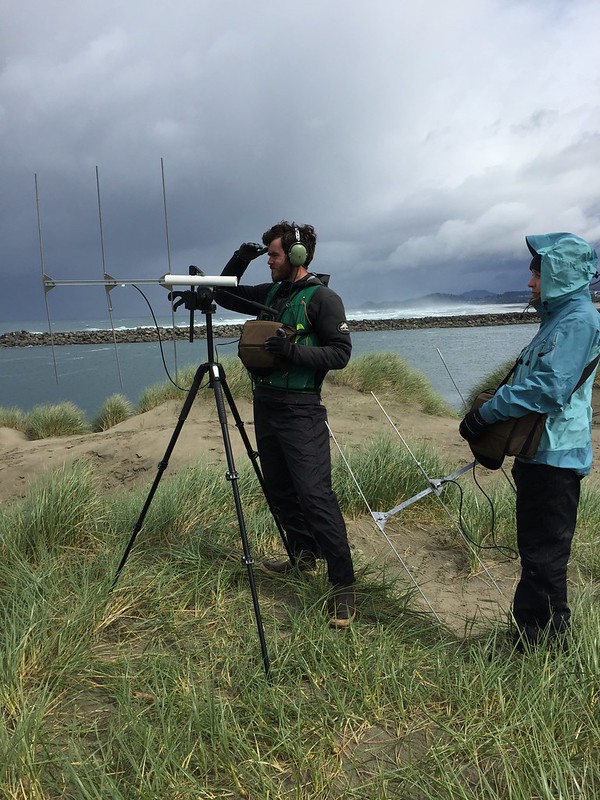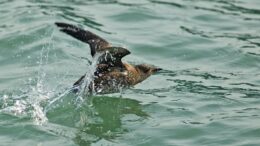One thing sets marbled murrelets apart from other seabirds: They forage at sea but nest inland in mature forests. That makes them a “bird of two worlds,” says Oregon State University animal ecologist Jim Rivers.
But this unique characteristic also increases their vulnerability. Climate change threatens murrelets’ food sources in the ocean, while on land, logging, wildfires and habitat fragmentation have diminished their nesting forests.
Although the birds received Endangered Species Act protection as a threatened species in 1992, their decline continued as logging chipped away at their forest habitats along the Pacific Coast of North America. Last year the results of a study by OSU researchers with the Oregon Marbled Murrelet Project analyzing 20 years of data revealed climate change and reduced prey populations as the additional factor in the murrelets’ decline.
The Revelator spoke with Rivers, principal investigator of the project, about the challenges of tracking murrelets and how their research is guiding conservation.

Why was this project started?
There’s a lot of uncertainty about the steps that are needed to recover murrelet populations. That has led managers to not really be sure in some cases as to what they can and can’t do in a given area.
So what our project aims to do is uncover some of the breeding requirements for murrelets. In particular we want to know about where birds are nesting and how successful they are in their nesting. And then if their nest failed to produce any offspring, we want to know the limiting factors and whether or not those might be factors that can be managed.
There isn’t much known about murrelet nesting success in Oregon. There’ve been other large studies in British Columbia, California, Washington and Alaska, but nothing in Oregon. Prior to the start of our work, there were only 29 nests that were active when they were located.
Murrelets use older forests — late succession and old-growth forests — for nesting. They also use the ocean for all of their foraging. They’re a unique species in that sense, but from a research perspective, that means our project requires a lot of people on the ground, in the air and on the water.
We didn’t want to start in the forest and potentially bias where we’re searching for nests. So what that required us to do is to go out and capture birds on the ocean and then tag them and then follow them inland. We do that so that we have a hopefully unbiased sample of birds that could go into federal sites or private lands or state lands.
What’s the process like for capturing these birds in the ocean and then tracking them all the way back to a nest site in the forest?
We go out on the water with an 84-foot boat from the beginning of May to the first week of June when the weather conditions are OK. When we get out on the water, we have a Zodiac [inflatable boat] that’s offloaded just after nightfall. A group gets into that capture boat and goes out into the nearshore environment. They look for birds with a spotlight and a salmon net. It sounds funny, but that’s as simple as we need.
When a bird is caught, they bring it back to the main boat where we have a crew attach a radio tag that allows us to track its movements over the course of about three months. Then we take a measurement of the body, as well as blood and feather samples, which tell us about the health of the bird. Then it’s released back to the water.
The tracking part starts the next morning with our ground crew, who look for the birds along the water. What we want to find is a bird that’s on the water one day, then missing the next day. And then it’s on the water the third day and it’s missing the fourth.
That’s suggestive of a bird in the process of incubating an egg. Males and females share in that responsibility, and they take 24-hour shifts. When we find that, that’s when we send the plane up to look for that individual bird.
The plane flies around and looks for the signal. Once we find the location where the bird is likely sitting on a nest, the ground crew goes inland and starts looking for that individual bird in a given tree, which isn’t easy. These birds are nesting 200 feet above the ground — not even in a nest, but in just a scrape in the moss on a horizontal limb. So you can’t see the bird from the ground.
Once we narrow it down, we have a tree climber set up a video camera in an adjacent tree so we can zoom in and get a good idea of what’s going on at the nest site without bothering the birds.
Then we just run that camera for as long as the nest is active. Once the nest ends, we go out and take down the cameras and we take measurements of the nest tree itself. We do that whole process for as many nests we can find.
What have you learned?
We’ve learned that the ocean conditions appear to have a really big influence on whether these birds are nesting or not. The first year of the project that we went full-scale on our tagging effort was 2017 and we tagged 61 birds. And we waited and waited and waited. None of those birds ended up breeding.

And that was a huge surprise to us. We really kind of scratched our heads. But one of the things that stood out during 2017 was that the coastal marine conditions in central Oregon were really poor for a bird like a murrelet that relies on forge fish to feed its offspring.
In 2018 and 2019, we went back with the same methodology. And we did have birds that were going in and breeding. We had about a dozen nests that we found, which is still not a very high propensity to breed and pretty uncommon relative to the number of birds that we tagged.
This year it’s been a very different story. The ocean has been quite a bit different in terms of the upwelling and the productivity and the forage fish availability. And what we’re finding is that we have the smallest number of tagged birds this year — just under 50 birds, but a third of those birds have bred.
We have 17 nests at last count for this season — much more than we had in all previous three seasons. We didn’t work last year because of COVID.
So we’re learning that you need to have good ocean conditions if murrelets are going to breed. And they have to have good nest sites in the forest. If you don’t have those, you’re not going to have healthy populations.
Have any of your findings so far been able to inform policy or conservation work?
Right now, the way that the regulations are written, at least for state lands in Oregon, is that if you go out to a site that might be murrelet habitat and you conduct a series of surveys and you don’t get any birds in the first year, and you go back the second year and you get the same result — no birds after a set number of surveys — that area can be harvested because it’s considered to be unoccupied habitat.
What our results showed was that you may have a couple of bad years of ocean conditions, but that doesn’t necessarily mean it’s an unoccupied habitat forever. It just means that birds are not using it because the ocean is not allowing them to, in a sense, because they don’t have the breeding resources.
Although our project really started as one that’s focused on nest ecology and breeding in the forest, we really can’t remove it from the ocean conditions too, because they’re tied together.
So we’ve done a little bit more work toward that marine side of things lately. And I think that’s where people are starting to really appreciate murrelets as a bird of two worlds.
What else are you hoping to learn?
The nice thing about this project is that we’ve had the latitude to ask questions that are related to our initial goal of understanding factors related to nest success. One of the questions is about ocean conditions and forage fish.
We’ve started to think about what the birds are eating, and we can get a sense of that from taking their blood and feather samples and looking at stable isotope values. Those give us a sense of how high in the food chain murrelets are eating. We can look at those values for different individuals and in different years. It will be interesting to see the potential difference in isotope values for birds that were captured this spring versus back in 2017 when none of them bred. I suspect they’ll be quite different.
We’re also getting interested in microplastics. It’s a threat to a lot of seabirds.
One of the things that we can do when we climb these nest trees and take measurements around the nest site is collect the fecal material from the chick. We can look through that and see what sort of plastics are there. And we have a woman on campus we’re collaborating with who does a lot of microplastics work. Her comment was, “it’s not a question of if, it’s a question of how much [microplastics] these birds are going to have.”
We’ve also been trying to understand where these birds are spending time on the coasts and whether or not their movements overlap with marine protected areas.
We’re kind of starting from the point of nesting ecology, but there’s lots of fun things that we can do that really broaden the work and help us understand the bird better.
![]()


